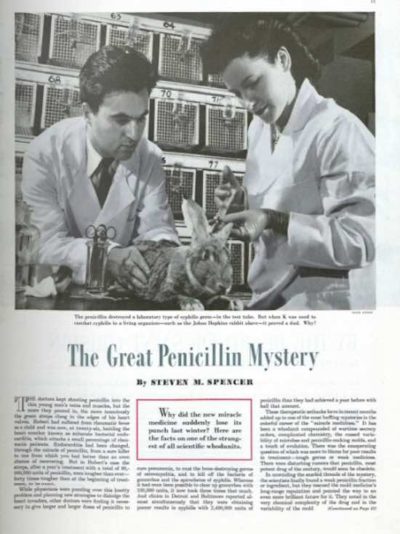On March 14, 1942, penicillin was first used in the United States to treat a bacterial infection. The good news was that it worked. The bad news was that half of all the available experimental supply was dispensed on that first patient. World War II was raging, and the War Production Board needed millions of doses for sick and wounded soldiers. The problem was that scientists hadn’t figured out how to scale production of the persnickety penicillium mold.
Enter Doctors Robert D. Coghill and Kenneth B. Raper of the Department of Agriculture’s Northern Regional Laboratory in Peoria, Illinois. According to an article by Steven M. Spencer in the August 3, 1946, issue of the Post, they “found in a cantaloupe a strain of mold which gave a much higher yield of penicillin than any of the original varieties.” They sent the mold to Dr. Milislav Demerec at Carnegie Mellon Institute, who used X-rays to achieve an even higher penicillin yield.
The spores from the moldy melon were used to seed almost all of the penicillin production facilities at the time, saving the lives of countless soldiers and civilians:
All told, the penicillin output has grown from an amount in January, 1943, sufficient to treat only ten patients a month to a volume that will today treat 1,000,000 patients a month.
Three years later, in 1946, scientists and pharmaceutical companies were still struggling to perfect the drug. Mold-growing techniques were still crude, and different strains produced dramatically different results. And even 70 years ago, researchers realized that drug-resistant germs would be a problem. The author writes, “For in our use of the modern sharpshooting chemicals we often unwittingly aid and speed up the subtle evolution forces which arrange for the survival of the fittest microbes.”
Even with its problems — both those known in 1946 and those yet undiscovered — penicillin was indeed a miracle drug, and we all owe much to that moldy melon. Without it, many of our grandparents and great-grandparents would not have lived through the war, and we, their distant offspring, wouldn’t be here at all.

Become a Saturday Evening Post member and enjoy unlimited access. Subscribe now




Comments
Today I learned the importance of moldy cantaloupe…
well, it’s good to know that the moldy cantelope i ate is hopefully a blessing in disguise
Thank you Ms. Bortel for running this feature again now. I’m not sure how I missed it almost 3 years ago, but AM sure I’m in the middle of a round of amoxicillin currently for a sinus infection that has already made a world of difference. It’s also helped with my sore throat in addition to gargling with warm salt water.
I feel bad for people that are allergic to the drug, because it really IS a miracle (drug) when needed. I try to use natural healing with lots of water, lemon juice, Vitamin C capsules and rest, but sometimes you have to ‘bring in the militia’ in addition to that. And yes, I’m taking the whole round per my prescription!